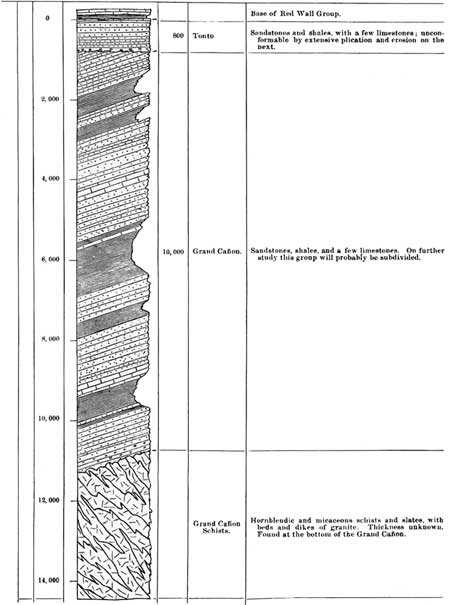
|
Geological Survey Professional Paper 669
The Colorado River Region and John Wesley Powell |
JOHN WESLEY POWELL'S COLORADO RIVER TRIPS OF 1869 AND 1871-72
During two trips by boat down the Colorado River and through the Grand Canyon, Maj. John Wesley Powell not only explored unknown territory, but he also made many significant observations of little known features, especially in the field of geology. In his report on these explorations, Powell (1875) recorded many aspects of erosion and developed certain basic concepts of land destruction such as base level and stream antecedence. In addition, he described and classified the major types of structure, such as monoclines and faults, responsible for segmentation of the uplifted plateau. His original contributions to the youthful science of geology were numerous, and most of his concepts have proved to be valid.
In view of Powell's great interest in geology and keen powers of observation, the general lack of references in his report to the stratigraphy of Grand Canyon—the open book of earth history where stratification dominates the view—seems, at first, very surprising. Only the Carboniferous rocks were referred to by name, and the correlations suggested in the reports of earlier geologists were not mentioned; nor were ideas concerning the genesis of these strata discussed in detail. Perhaps the answer is that Powell was so beset with difficulties and so occupied with matters of survival when in the Grand Canyon that he could give little thought to these matters; however, a more likely reason for the omission was his lack of any formal training in geology. At this stage in his career he had little knowledge of details of stratigraphy, and if he was familiar with the earlier work in the Grand Canyon area by Marcou and Newberry, there is nothing to indicate it. He was a self-trained and self-made man.
Despite the lack of general stratigraphic data in Powell's report, he must be credited with making the first reference to a very significant feature in the record of Grand Canyon history. His discussion of the two great unconformities, between early and late Precambrian and between Precambrian and Paleozoic strata, is classic. He not only correctly analyzed the sequence of events, but he showed in forceful language its meaning in terms of deposition, mountain building, volcanism, and erosion. Unfortunately his illustration of the three great rock sequences (reproduced as fig. 3 of this publication) is incorrectly drawn. (Note the relation of dipping upper Precambrian strata to the erosion surface on the underlying schists and granites.) In a later publication (Powell, 1876, table, p. 43), the correct relationships are shown. (See fig. 4 of this publication.) Nevertheless, he recognized that in the upper Precambrian or middle rock sequence, a topographic thickness of only a few hundred feet represents 10,000 feet of stratigraphic thickness, and he apparently visualized the tremendous amount of erosion that was required to bring about this base leveling or wearing away of mountains.

|
| FIGURE 3.—Section in the north wall of the Grand Canyon illustrating the unconformity between (A) lower Precambrian schists and (B) steeply dipping upper Precambrian beds and the unconformity between (B) upper Precambrian and (C) Paleozoic strata. From Powell (1875, fig. 79). |

|
| FIGURE 4.—Base of stratigraphic section in the Grand Canyon. From Powell (1876, p. 43). (click on image for an enlargement in a new window) |
| <<< Previous | <<< Contents >>> | Next >>> |
pp/669/secb3.htm
Last Updated: 22-Jun-2006